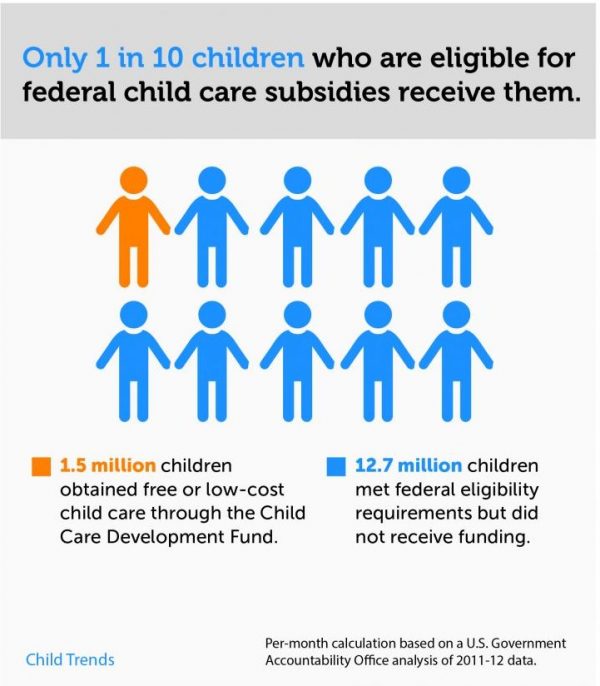Why millions of eligible children miss out on federal child care grants
Author
Since 1990, the federal government has helped low-income working families obtain free or low-cost child care through the Child Care and Development Fund (CCDF). According to an analysis from the Government Accountability Office (GAO), in 2011 and 2012 (the most recent data available), each month an average of 1.5 million children under age 13 obtained free or low-cost child care through CCDF.
But the report also revealed that, over the same time, a monthly average of 12.7 million other children met the federal eligibility requirements for that same funding yet didn’t receive it. That means nearly 90 percent of eligible children didn’t benefit from federal child care subsidies that are intended to help them.
To understand why, let’s take a look at the barriers that prevent federally eligible children from accessing CCDF funding.
Challenges with the CCDF program
Some low-income families never apply for CCDF subsidies at all, either because the application process is difficult to navigate, there aren’t enough nearby providers who will accept a subsidized child, or they don’t know about subsidies in the first place.
But according to the GAO report, a larger problem is that states have more eligible children than they have funding to serve. To manage their caseload, they may put children on waitlists or freeze the intake of new families. Stakeholders and administrators have expressed concern that the amount of unmet need will only grow.
The CCDF program is also a block grant, which means states have substantial flexibility in deciding how to use the funds to help children who might need it most—often the poorest children, children with special needs, or children in the child welfare system. To prioritize their limited funds, states often make their CCDF eligibility criteria more restrictive than those set by the federal government. For example, federal guidelines state that CCDF subsidies may only go to families with an income less than 85 percent of their state’s median income, but almost all states use a more restrictive income threshold than that.
Eligibility also varies greatly from state to state. In New Mexico, nearly 100 percent of federally eligible children qualify for a subsidy based on state policies, whereas only about 40 percent of such children qualify in Iowa. Across the 50 states and Washington, DC, only 61 percent of federally eligible children are also eligible in their home state.
Even when a family qualifies under both federal and state requirements, they are not guaranteed a CCDF subsidy. In New Mexico—the state with eligibility requirements closest to the federal government’s—just 21 percent of eligible children received a subsidy each month in 2011 and 2012.
Solutions
The cost of child care continues to increase. According to many state administrators, there simply isn’t enough money in the block grant to serve the 12.7 million children who would likely benefit from this subsidy but are not receiving it, and historically, funding for block grants tends to drop over time. Federal policymakers should explore the likelihood that additional funding for CCDF would help more families get subsidies.
At the state level, the GAO report recommends keeping CCDF waitlists “current and accurate” to facilitate quicker contact with families when a subsidy becomes available. Caseworkers should have access to efficient waitlist management tools, such as web-based systems that are integrated with other case management systems.
In addition, researchers, state administrators, and federal staff can collaborate to ensure that CCDF subsidies are as accessible as possible. The federally funded Early Care and Education Access and Choices Workgroup, for example, has summarized research on child care subsidies to provide policymakers with an overview of the challenges to wider use of the CCDF subsidy. They found that some families are overwhelmed by the paperwork requirements or live too far away from programs to take advantage of the subsidy. Groups concerned with this issue might discuss these challenges to CCDF access in their state, and make research-informed recommendations for overcoming them.
© Copyright 2024 ChildTrendsPrivacy Statement
Newsletter SignupLinkedInThreadsYouTube